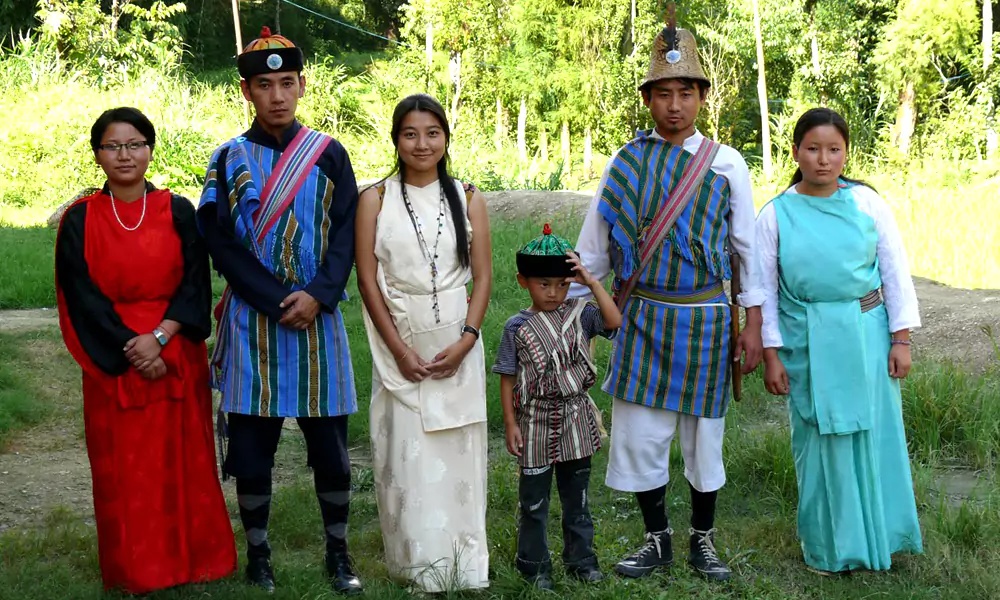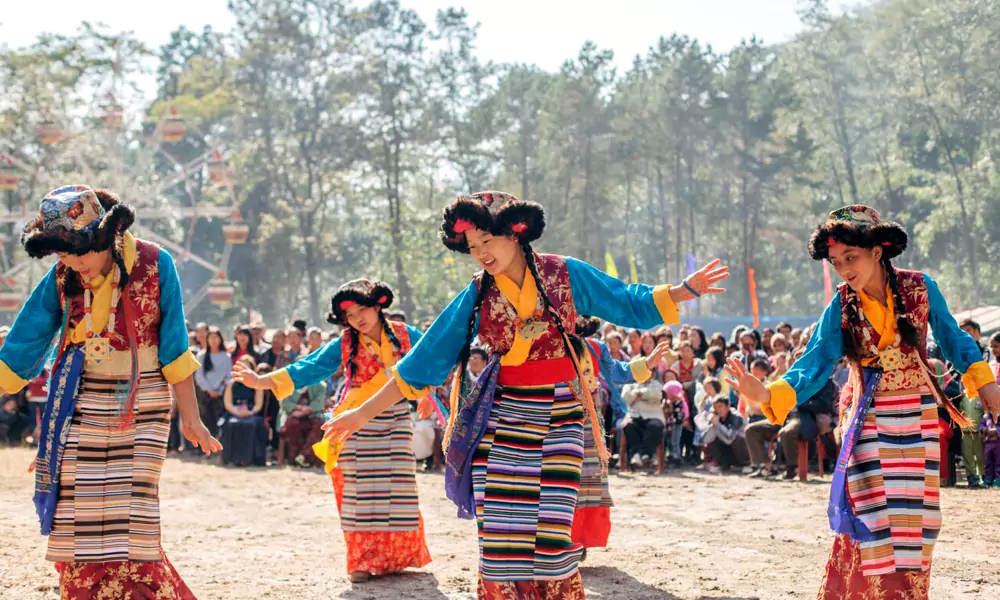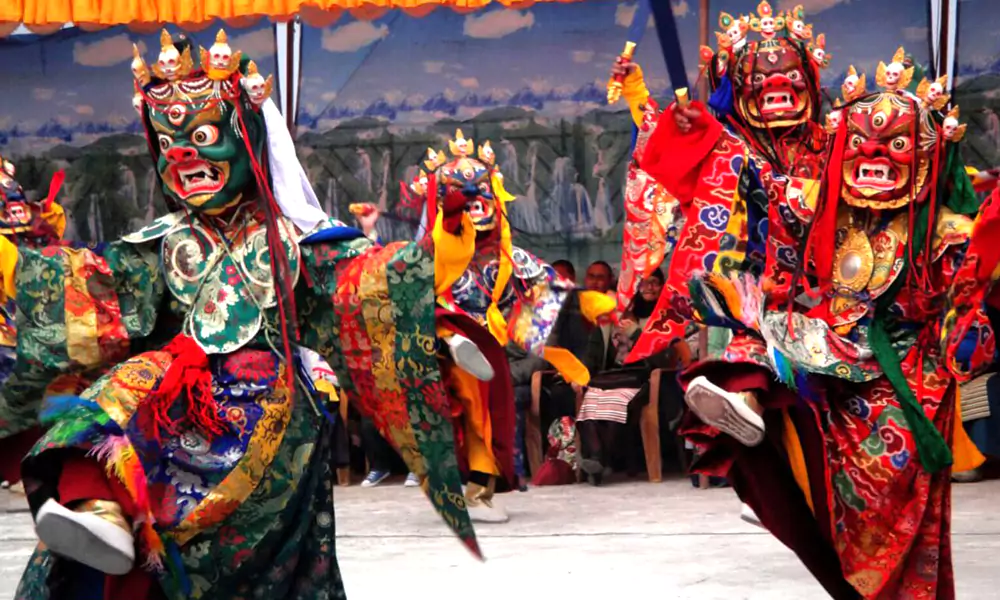Sikkim is a confluence of different traditions, as many Nepalese and Bhutias live there. For business purposes, many Biharis and Punjabis migrated to this incredible state. Diverse tribes and castes have contributed a variety of dances and Tradition of Sikkim that make this state unique. The Valley of Rice presents a bouquet of culture to welcome you to the land. If Sikkim is on your bucket list of places to visit, don’t forget to see their mask dance!
As a token of appreciation for Mount Khangchendzonga, Sikkimese celebrates Dussehra and Phang Labsol festivals. Other festivals are Losoong, Namoong, and Labab Duchen.
Arts and culture of Sikkim:
Diverse culture has a deep-rooted influence on the arts of this state.
- Thangyaka paintings: Monks and priests made these paintings related to Buddhism, and nowadays, these paintings are produced commercially.
- Religious places: Are you a godly person? For sure Sikkim is a heaven for you!
- Carpet weaving: The aesthetic design of the carpets in Sikkim makes everyone wonder as they dye them with natural vegetable colour. Do you know their secret? All are handwoven, and the designs are their imagination, showing their incredible creativity.
- Handlooms: Sikkim is famous for the handlooms for their aesthetic design and warmth. Foreign tourists prefer beautifully woven shawls in traditional designs and
Dress Sikkim people wear:
Sikkim Traditional Dress:

Sikkim is a land known for its vibrant culture and colourful dress. The indigenous tribes and kings ruled that part of the country and the locals wore traditional attire. Sikkimese attire gives you a taste of Tibetian, Nepalese, and Bhutanese traditional dress. No wonder! The reason is this state has many people from these countries. The complex designs and bright colours show the rich cultural heritage of these countries.
Major Traditional dresses of Sikkim:
- Bakhu.
- Tohr.
- Dotho.
- Tharo.
- Choktsee.
- Honju.
- Pangden.
- Kera.
Sikkim Traditional Dress for Women:
In Sikkim, you can see beautiful ladies wearing vibrant-coloured dresses. They usually wear silk clothes on which Choktees an auspicious symbol of Buddhism is printed. Sikkimese wear an honju silk blouse with these silk clothes and a wollen wrap-around skirt with attractive designs and kera to cover their face and shoulder in public places.
One thing notable about these dresses is the material from which they are made and who wears them. Affluent families wear silk dresses and the less affluent women wear woollen and cotton clothes. The women’s attire closely resembles Tibetian attire along with Bhutanese designs. Now, designers incorporate contemporary designs into traditional designs to make them more attractive.
Sikkim Traditional Dress for Men:
Baku, Tohr, Dotho, Tharo are some of the traditional attire for men. Dotho is a wrap-around Skirt, and Tohr is a shirt. Just like women’s Kera, Tharo is a scarf for men and they wear silk, cotton and commonly wool like Sikkimese women. Tibet and Bhutan continue to influence the attire of Sikkim. The dresses depict the mixed culture of Tibet and Bhutan and are worn in mountainous cold climates.
Sikkim government conducts events and festivals to showcase and protect its cultural heritage. The government urges the youth to learn about their culture to increase awareness about the tradition of Sikkim and take pride in it. Foreign fashion influence is the major challenge Sikkim traditional dresses face in Sikkim.
Must Read: Plan a trip to Sikkim this year: Places, Trekking & Lakes
Folk music and dance of Sikkim:

Sikkim music and dance have a tint of folk dance and music of three communities- Lepcha, Nepalis and Bhutia. Some Sikkimese folk dances and music depict the beauty of the surrounding landscape, and some others make you feel the joy the spring season brings with it. The songs are about harvest season, and some others bring good luck to the people. A group of young boys and girls dance to the tunes of traditional music and invoke Gods to bring good fortune.
Sikkim Folk Dance:
Sikkim rests in the lap of the mighty Himalayas, and the songs and dances of these people always centre around the mountains. Some traditional songs describe the beautiful nature, some the harvest season, and some others are for good fortune. Their dance shows the social customs and religious practices of the Sikkim people. The breathtaking nature of Sikkim entices the minds of everyone who visits this place.
Traditional Folk Dance of Sikkim:
- Singhi Chaam: Snow lion is an imaginary animal whose sight is auspicious to Sikkimese people. Singhi Chaam dance is one of the traditional folk dances of Sikkim that shows the white lion that comes alive in the dance, bringing luck to the people.
- Yak Chham: Yak is the best friend of those who reside on the rugged slopes of mountains. They give the wool to protect from dying cold, its milk to quench his thirst and make butter. Yak Chham is a dance in which the dancers wear yak skin and dance to enchanting music.
- Shelo: Shelo is a Nepalese traditional dance art in which young boys express their love for their loved ones. Dancers perform Shelo to express their love and affection for newly discovered love. The mesmerising melody of the song and the grace of dance brimming with love would coax the hearts of the girls who accept the proposals of the boys. This is one of the wonderful traditional folk dance forms of Sikkim.
- Sherpa dance: Sherpa dance costumes resemble Tibetian dresses and the dancers dance to tunes of a song praising God for the incredible land and cultural heritage. The dance and the song introduce the lifestyle of Sherpas, who are proud of their rich heritage. Through their songs, they pray for peace and prosperity in their land.
Music of Sikkim:
Tamang Selo is the music of Sikkim, which is a Nepali traditional music that came to India along with Nepali people settled in Sikkim. Dhampu is a musical instrument Sikkimese uses that adds rhythm to the music. Sikkim people use other musical instruments like Madan Nand Tungna along with Dampu to bring out the beauty of the music and dance of Sikkim.
Traditional Festival of Sikkim:

There are many festivals that Sikkimese celebrate. It is a state that has absorbed different cultures and emerged as a resilient and tolerant state. Sikkim celebrates different festivals of many faiths, giving equal respect to all religions.
The Sikkim traditional festivals are:
- Maghe Santhi: Maghe Santhi marks the start of the harvest season. Maghe santhi is the main festival of Nepal, celebrated on the 14th of January every year.
- Sonam Lochar: Sonam Lochar is the Tamang community New Year celebration and it falls in the 12th month of the lunar calendar.
- Losar: Losar is a Tibetian New Year celebration celebrated with pomp and pride in Sikkim according to the Tibetian lunar calendar.
- Holi: Holi is a Hindu festival that symbolizes the victory of good over evil. People sprinkle colour water over others and enjoy.
Conclusion
Many communities peacefully coexist in Sikkim, making it a cultural basket of India. The aborigines of Sikkim are the Lepchas community to which Bhutias from Tibet joined along with Nepalese who form 80% of the inhabitants of Sikkim. A large number of Indians from various regions of the nation have relocated to Sikkim. Sikkim culture reflects the influence of each of these groups. Even with the government’s attempts, Sikkim maintains its ancient customs and culture. As a form of art, the music and dance of Sikkim represent the state’s cultural heritage.




Leave a Comment :